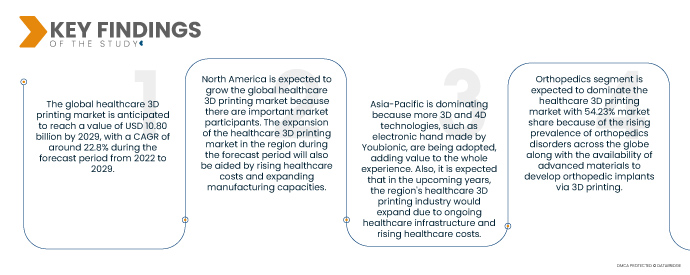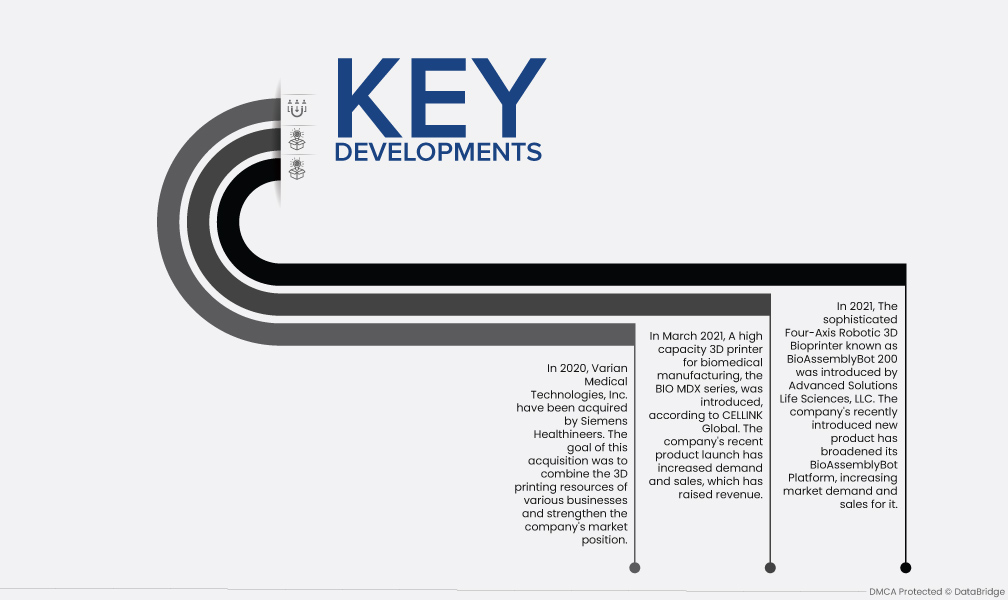3D printing is used for implant design and discovery to minimize the operation costs and reduces the time for surgery. It is also utilized in creating personalized medicine, a developing treatment field involving drug administration and dose. Personalized medicine shifts the trend away from one size fit for all, which increases the demand for 3D printing to create patient-specific implants (PSI). 3D printing in medicine is expanding quickly due to the rising demand for implants and tailored medication. These are the certain factors which propel the market growth.
Access Full Report @ https://www.databridgemarketresearch.com/reports/global-healthcare-3d-printing-market
Data Bridge Market Research analyses that the Healthcare 3D Printing Market is expected to grow at a CAGR of 22.8% in the forecast period of 2022 to 2029 and is expected to reach USD 10.80 billion by 2029 from USD 2.09 billion in 2021.

The surge in Investments in Research and Development Activities Related to 3D Printing is Expected to Drive the Market
The medical device industry's shifting purchasing patterns, a varied talent pool and a focus on ecosystem alliances that include partnerships with Tech companies, start-ups and service providers are just a few of the elements that have revolutionized the healthcare environment. The top five spenders account for 38% of global research and development expenditures. As a result, the market will grow.
Report Scope and Market Segmentation
|
Report Metric
|
Details
|
|
Forecast Period
|
2022 to 2029
|
|
Base Year
|
2021
|
|
Historic Years
|
2020 (Customizable to 2014 - 2019)
|
|
Quantitative Units
|
Revenue in USD Million, Volumes in Units, Pricing in USD
|
|
Segments Covered
|
Modality (Standalone, Integrated), Components (Material, Hardware, Software, Services), Technology (Bioprinting, Droplet Deposition/Extrusion-Based Technologies, Photopolymerization, Laser Beam Melting, Electron Beam Melting (EBM), 3DP/Adhesion Bonding/Binder Jetting, Others), Application (Medical, Surgical, Pharmaceutical, Others), Medical Specialty (Orthopedics, Dental, Cardiovascular, Craniomaxillofacial (CMF), Neurosurgery, Oncology, Others), End User (Medical and Surgical Centers, Research Centers and Academic Institutions, Pharmaceutical and Biotechnology Companies, Others)
|
|
Countries Covered
|
U.S., Canada and Mexico in North America, Germany, France, U.K., Netherlands, Switzerland, Belgium, Russia, Italy, Spain, Turkey, Rest of Europe in Europe, China, Japan, India, South Korea, Singapore, Malaysia, Australia, Thailand, Indonesia, Philippines, Rest of Asia-Pacific (APAC) in the Asia-Pacific (APAC), Saudi Arabia, U.A.E, South Africa, Egypt, Israel, Rest of Middle East and Africa (MEA) as a part of Middle East and Africa (MEA), Brazil, Argentina and Rest of South America as part of South America
|
|
Market Players Covered
|
Carbon, Inc. (U.S.), Formlabs (U.S.), 3T Additive Manufacturing Ltd (U.K.), Stratasys Ltd. (U.S.), 3D Systems, Inc. (U.S.), Organavo Holdings Inc. (U.S.), CYFUSE BIOMEDICAL K.K. (Japan), CELLINK (U.S.), Anatomics Pty Ltd (Australia), Block.one. (Germany), Renishaw plc (U.K.), SLM Solutions (Germany), FIT AG (Germany), Prodways Technologies (France), BOSON MACHINES (India), Advanced Solutions Life Sciences, LLC (U.S.), Tinkerine Studios Ltd. (Canada) and Wacker Chemie AG (Germany)
|
|
Data Points Covered in the Report
|
In addition to the insights on market scenarios such as market value, growth rate, segmentation, geographical coverage, and major players, the market reports curated by the Data Bridge Market Research also include depth expert analysis, patient epidemiology, pipeline analysis, pricing analysis, and regulatory framework.
|
Segment Analysis:
The healthcare 3D printing market is segmented on the basis of modality, components, technology, application, medical specialty and end user.
- On the basis of modality, global healthcare 3D printing market is segmented into standalone and integrated. Standalone segment is expected to dominate the healthcare 3D printing market with 83.49% market share due to the availability of technologically advanced standalone 3D printing devices and increased R&D by key market players for the launch of advanced standalone systems.
- On the basis of components, global healthcare 3D printing market is segmented into material, hardware, software and services. Material segment is expected to dominate the healthcare 3D printing market with 50.44% market share because of the increased R&D for the segment leading to the development of advanced materials for 3D printers and bio printers.
- On the basis of technology, global healthcare 3D printing market is segmented into bioprinting, photopolymerization, laser beam melting, electron beam melting (EBM), droplet deposition/extrusion-based technologies, 3DP/adhesion bonding/binder jetting and others. Bioprinting segment is expected to dominate the healthcare 3D printing market with 42.31% market share because of the novel technology which acts as an alternative to animal testing, also it can decrease the waiting list for organ donors.
- On the basis of application, global healthcare 3D printing market is segmented into medical, surgical, pharmaceutical, others.
The medical segment is expected to account for the largest share of method type segment in the healthcare 3D printing market
The medical segment holds maximum CAGR of 16.7% owing to its advanced applications of tissue engineering being explored by various research institutes for innovation in medicine.
- On the basis of medical specialty, global healthcare 3D printing market is segmented into dental, cardiovascular, craniomaxillofacial (CMF), orthopedics, neurosurgery, oncology and others.
Orthopedics segment is expected to dominate the healthcare 3D printing market
Orthopedics segment is expected to dominate the healthcare 3D printing market with 54.23% market share because of the rising prevalence of orthopedics disorders across the globe along with the availability of advanced materials to develop orthopedic implants via 3D printing.
- On the basis of end user, global healthcare 3D printing market is segmented into medical & surgical centers, research centers and academic institutions, pharmaceutical & biotechnology companies and others. Medical & surgical centers segment is expected to dominate the healthcare 3D printing market with 59.41% market share because of the emergence of COVID-19 and increased prevalence of orthopedic diseases surged the demand for medical devices and orthopedic implants in these places.
Major Players
Data Bridge Market Research recognizes the following companies as the major Carbon, Inc. (U.S.), Formlabs (U.S.), 3T Additive Manufacturing Ltd (U.K.), Stratasys Ltd. (U.S.), 3D Systems, Inc. (U.S.), Organavo Holdings Inc. (U.S.), CYFUSE BIOMEDICAL K.K. (Japan), CELLINK (U.S.), Anatomics Pty Ltd (Australia), Block.one. (Germany), Renishaw plc (U.K.), SLM Solutions (Germany), FIT AG (Germany), Prodways Technologies (France), BOSON MACHINES (India), Advanced Solutions Life Sciences, LLC (U.S.), Tinkerine Studios Ltd. (Canada) and Wacker Chemie AG (Germany)

Market Development
- In 2020, Varian Medical Technologies, Inc. was acquired by Siemens Healthineers. This acquisition aimed to combine the 3D printing resources of various businesses and strengthen the company's market position.
- In March 2021, a high-capacity 3D printer for biomedical manufacturing, the BIO MDX series, was introduced, according to CELLINK Global. The company's recent product launch has increased demand and sales, which has raised revenue.
- In 2021, The sophisticated Four-Axis Robotic 3D Bioprinter known as BioAssemblyBot 200 was introduced by Advanced Solutions Life Sciences, LLC. The company's recently introduced new product has broadened its BioAssemblyBot Platform, increasing market demand and sales for it.
Regional Analysis
Geographically, the countries covered in the paint protection film market report are U.S., Canada and Mexico in North America, Germany, France, U.K., Netherlands, Switzerland, Belgium, Russia, Italy, Spain, Turkey, Rest of Europe in Europe, China, Japan, India, South Korea, Singapore, Malaysia, Australia, Thailand, Indonesia, Philippines, Rest of Asia-Pacific (APAC) in the Asia-Pacific (APAC), Saudi Arabia, U.A.E, South Africa, Egypt, Israel, Rest of Middle East and Africa (MEA) as a part of Middle East and Africa (MEA), Brazil, Argentina and Rest of South America as part of South America
As per Data Bridge Market Research analysis:
North America is the dominant region in healthcare 3D printing market in the forecast period 2022 - 2029
North America is expected to grow the global healthcare 3D printing market because there are important market participants. The expansion of the healthcare 3D printing market in the region during the forecast period will also be aided by rising healthcare costs and expanding manufacturing capacities.
Asia-Pacific is estimated to be the fastest-growing region in healthcare 3D printing market in the forecast period 2022 - 2029
Asia-Pacific is dominating because more 3D and 4D technologies, such as electronic hand made by Youbionic, are being adopted, adding value to the whole experience. Also, it is expected that the region's healthcare 3D printing industry will expand in the upcoming years due to ongoing healthcare infrastructure and rising healthcare costs.
For more detailed information about the Healthcare 3D printing market report, click here – https://www.databridgemarketresearch.com/reports/global-healthcare-3d-printing-market











